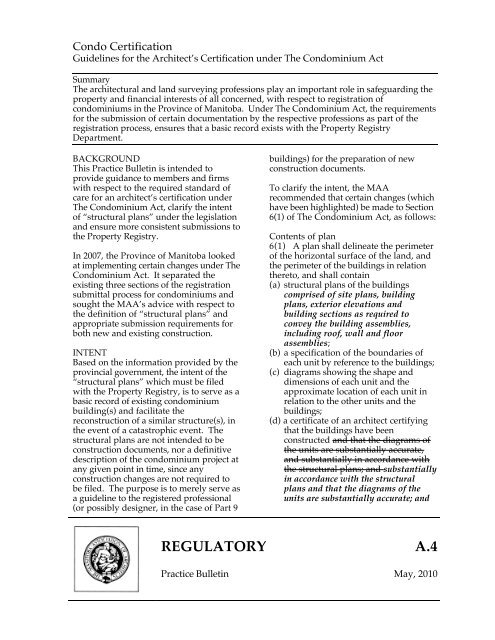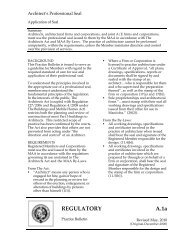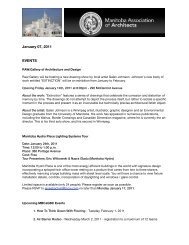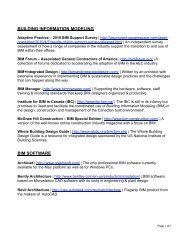Condo Certification - Manitoba Association of Architects
Condo Certification - Manitoba Association of Architects
Condo Certification - Manitoba Association of Architects
Create successful ePaper yourself
Turn your PDF publications into a flip-book with our unique Google optimized e-Paper software.
<strong>Condo</strong> <strong>Certification</strong><br />
Guidelines for the Architect’s <strong>Certification</strong> under The <strong>Condo</strong>minium Act<br />
Summary<br />
The architectural and land surveying pr<strong>of</strong>essions play an important role in safeguarding the<br />
property and financial interests <strong>of</strong> all concerned, with respect to registration <strong>of</strong><br />
condominiums in the Province <strong>of</strong> <strong>Manitoba</strong>. Under The <strong>Condo</strong>minium Act, the requirements<br />
for the submission <strong>of</strong> certain documentation by the respective pr<strong>of</strong>essions as part <strong>of</strong> the<br />
registration process, ensures that a basic record exists with the Property Registry<br />
Department.<br />
BACKGROUND<br />
This Practice Bulletin is intended to<br />
provide guidance to members and firms<br />
with respect to the required standard <strong>of</strong><br />
care for an architect’s certification under<br />
The <strong>Condo</strong>minium Act, clarify the intent<br />
<strong>of</strong> “structural plans” under the legislation<br />
and ensure more consistent submissions to<br />
the Property Registry.<br />
In 2007, the Province <strong>of</strong> <strong>Manitoba</strong> looked<br />
at implementing certain changes under The<br />
<strong>Condo</strong>minium Act. It separated the<br />
existing three sections <strong>of</strong> the registration<br />
submittal process for condominiums and<br />
sought the MAA’s advice with respect to<br />
the definition <strong>of</strong> “structural plans” and<br />
appropriate submission requirements for<br />
both new and existing construction.<br />
INTENT<br />
Based on the information provided by the<br />
provincial government, the intent <strong>of</strong> the<br />
“structural plans” which must be filed<br />
with the Property Registry, is to serve as a<br />
basic record <strong>of</strong> existing condominium<br />
building(s) and facilitate the<br />
reconstruction <strong>of</strong> a similar structure(s), in<br />
the event <strong>of</strong> a catastrophic event. The<br />
structural plans are not intended to be<br />
construction documents, nor a definitive<br />
description <strong>of</strong> the condominium project at<br />
any given point in time, since any<br />
construction changes are not required to<br />
be filed. The purpose is to merely serve as<br />
a guideline to the registered pr<strong>of</strong>essional<br />
(or possibly designer, in the case <strong>of</strong> Part 9<br />
buildings) for the preparation <strong>of</strong> new<br />
construction documents.<br />
To clarify the intent, the MAA<br />
recommended that certain changes (which<br />
have been highlighted) be made to Section<br />
6(1) <strong>of</strong> The <strong>Condo</strong>minium Act, as follows:<br />
Contents <strong>of</strong> plan<br />
6(1) A plan shall delineate the perimeter<br />
<strong>of</strong> the horizontal surface <strong>of</strong> the land, and<br />
the perimeter <strong>of</strong> the buildings in relation<br />
thereto, and shall contain<br />
(a) structural plans <strong>of</strong> the buildings<br />
comprised <strong>of</strong> site plans, building<br />
plans, exterior elevations and<br />
building sections as required to<br />
convey the building assemblies,<br />
including ro<strong>of</strong>, wall and floor<br />
assemblies;<br />
(b) a specification <strong>of</strong> the boundaries <strong>of</strong><br />
each unit by reference to the buildings;<br />
(c) diagrams showing the shape and<br />
dimensions <strong>of</strong> each unit and the<br />
approximate location <strong>of</strong> each unit in<br />
relation to the other units and the<br />
buildings;<br />
(d) a certificate <strong>of</strong> an architect certifying<br />
that the buildings have been<br />
constructed and that the diagrams <strong>of</strong><br />
the units are substantially accurate,<br />
and substantially in accordance with<br />
the structural plans; and substantially<br />
in accordance with the structural<br />
plans and that the diagrams <strong>of</strong> the<br />
units are substantially accurate; and<br />
REGULATORY<br />
Practice Bulletin<br />
A.4<br />
May, 2010
(e)a description <strong>of</strong> any interest<br />
appurtenant to the land that is<br />
included in the property.<br />
The MAA also recommended that the<br />
certification statement provided by<br />
architects, be revised to read as follows:<br />
I hereby certify that the buildings have been<br />
constructed substantially in accordance with<br />
the structural plans and that the diagrams <strong>of</strong><br />
the units are substantially accurate.<br />
SUBMISSION REQUIREMENTS<br />
As a result <strong>of</strong> the changes that the<br />
Province has been able to implement,<br />
Parts 1 and 2 must now be certified by a<br />
land surveyor registered to practice in<br />
<strong>Manitoba</strong> and Part 3 must be certified by<br />
an architect registered to practice in<br />
<strong>Manitoba</strong>. The architect must also review<br />
Parts 1 and 2, to confirm that they are<br />
substantially accurate relative to the<br />
submitted structural plans.<br />
The architect must sign the certification<br />
statement on the documentation to be<br />
filed (a seal in not required).<br />
The Property Registry has established<br />
internal guidelines which outline the<br />
appropriate level <strong>of</strong> detail required in the<br />
building registration submission, based on<br />
the recommendations <strong>of</strong> the MAA as to<br />
the appropriate standard. The<br />
requirements differ for new construction<br />
and the registration <strong>of</strong> existing buildings<br />
which are converted to condominiums and<br />
are as follows:<br />
New Construction<br />
Structural plans <strong>of</strong> the building. This<br />
part is to be reviewed and signed by<br />
an Architect. Structural plans are to<br />
include the following:<br />
• Site plan(s), indicating the location<br />
<strong>of</strong> the building(s), site layout and<br />
identification <strong>of</strong> all accessory<br />
structures;<br />
• Building plan(s), dimensioned for<br />
all levels and indicating ro<strong>of</strong>, wall<br />
and floor assemblies;<br />
• Exterior elevations, indicating the<br />
exterior finishes <strong>of</strong> the building;<br />
• Building Section(s), indicating the<br />
dimensions and general building<br />
assemblies.<br />
Existing Construction<br />
Structural plans <strong>of</strong> the building. This<br />
part is to be reviewed and signed by<br />
an Architect. Structural plans are to<br />
include the following:<br />
• Site plan(s), indicating the location<br />
<strong>of</strong> the building(s), site layout and<br />
identification <strong>of</strong> all accessory<br />
structures;<br />
• Building plan(s), dimensioned for<br />
all levels and indicating ro<strong>of</strong>, wall<br />
and floor assemblies that can be<br />
determined with nondestructive<br />
examination;<br />
• Exterior elevations, indicating the<br />
exterior finishes <strong>of</strong> the building.<br />
Large scale, monochrome<br />
photographs may be utilized in<br />
lieu <strong>of</strong> measured drawings;<br />
• Building Section(s), indicating the<br />
dimensions and general building<br />
assemblies that can be determined<br />
with nondestructive examination.<br />
Members must ensure that the submission<br />
which is provided to the Property Registry<br />
is consistent with the above-noted<br />
guidelines. Members must NOT simply<br />
provide a complete set <strong>of</strong> construction<br />
documents, which contain far in excess <strong>of</strong><br />
the documentation required; this would be<br />
as much <strong>of</strong> a concern as filing insufficient<br />
information to provide the necessary<br />
guidance intended under the provisions <strong>of</strong><br />
Section 6(1) <strong>of</strong> The <strong>Condo</strong>minium Act.<br />
When can the architect certify?<br />
Members who are involved in the<br />
provision <strong>of</strong> architectural services on new<br />
construction for a condominium project,<br />
may be pressured to provide certification<br />
under The <strong>Condo</strong>minium Act prior to<br />
completion <strong>of</strong> the construction project. It<br />
is acceptable for a member to provide<br />
architectural certification, once a sufficient<br />
level <strong>of</strong> the construction has been<br />
completed to confirm that construction <strong>of</strong><br />
the building(s) is substantially in<br />
accordance with the documentation filed<br />
as part <strong>of</strong> the submission. If proper<br />
attention is paid to the submission<br />
requirements and the appropriate<br />
documentation is filed, then certification<br />
can certainly take place in advance <strong>of</strong><br />
completion <strong>of</strong> the project.
Part 9 Buildings<br />
An architect’s certification is required for<br />
all condominiums, including Part 9<br />
buildings where no architect may have<br />
been involved in the preparation <strong>of</strong><br />
construction documents. In providing the<br />
architect’s certification for the purposes <strong>of</strong><br />
The <strong>Condo</strong>minium Act, the architect does<br />
not assume any liability for the<br />
construction documents (unless the<br />
construction documents were also<br />
prepared and sealed by that architect).<br />
Rather, the certification is simply<br />
confirming that the buildings have been<br />
constructed substantially in accordance<br />
with the documentation provided and<br />
that the diagrams <strong>of</strong> the units (provided<br />
as part <strong>of</strong> the land surveyors portion <strong>of</strong><br />
the submission) are substantially accurate.





